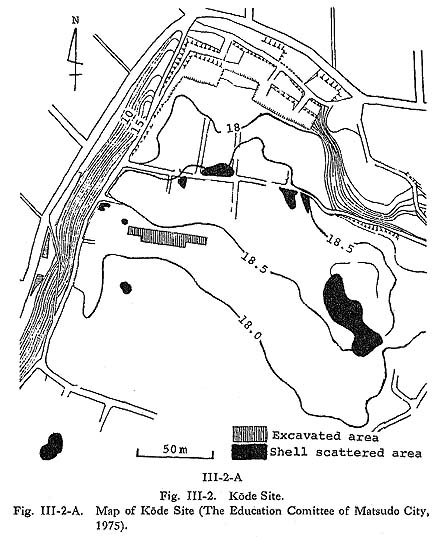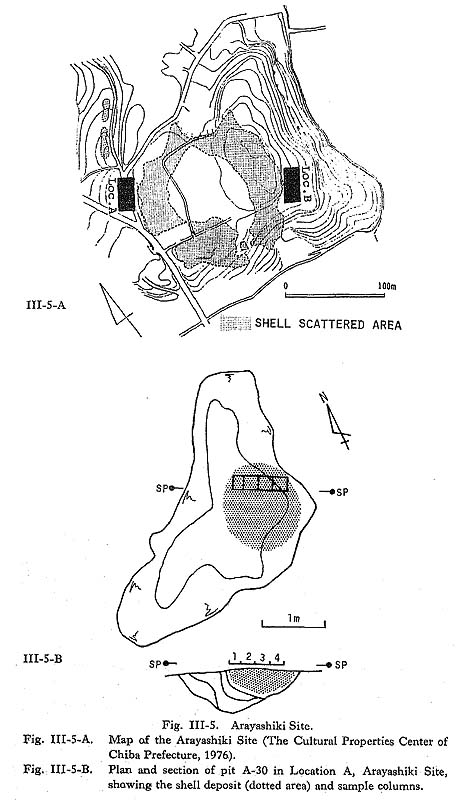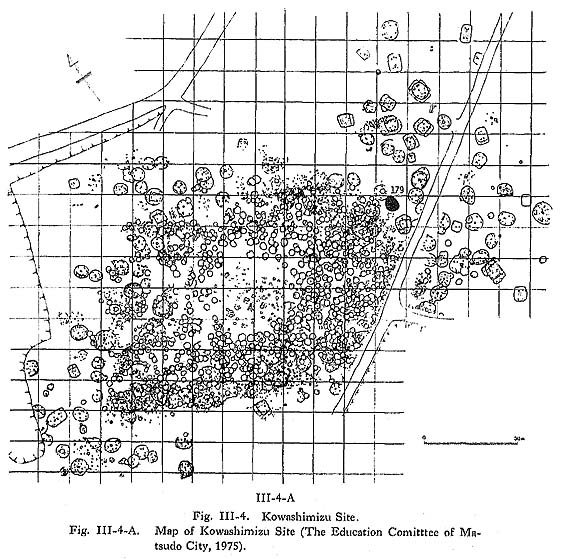PART II. SEASONALITY OF SHELL-COLLECTING
ACTIVITIES IN PREHISTORIC JAPAN
I. Historical Review of Shell-Midden Studies in Japan
|
The first scientific excavation of a prehistoric site in Japan was carried out in 1877 by Prof. E. S. Morse, an American conchologist who was interested in the microevolu-tion of molluscan shells found in shell-midden sites. The "Shell Mounds of Omori" (Morse, 1879) was the first description of a prehistoric shell-midden site in Japan. This site was thought to correspond to shell-midden sites in Denmark and Florida in the U.S.A. (Wyman, 1875); publication of the finding was a great stimulus to Japanese historians. Subsequently, the Anthropological Society of Nippon was established in 1886, and prehistoric finds one after another were reported and discussed in the Society's journal. The second period of prehistoric research in Japan seems to have begun with the stratigraphical excavations in the 1920's. Over the next few decades typologies were worked out for Jomon pottery (Yamanouchi, 1939) and other artifacts; a chronology of sites was then set up based on pottery types and shell assemblage (Sakazume, 1942); and the identification of animal bones (Hasebe, 1929; Naora, 1941) and molluscan shells (Oyama, 1940) was established by the 1950's. The Jomon period was divided into 5 stages (Earliest, Early, Middle, Late, Latest), and each stage was subdivided into about 6 phases (although recently the subdivision has been expanded into 10 or more phases). Shortly after that a catalogue of over 800 shell-midden sites was published giving the locality of each site and its pottery types, the kind of animal bones found, and the molluscan shell assemblage (Sakazume, 1958). Ecological studies mark the third stage of prehistoric research. This stage came with the introduction of C-14 dating which enabled comparisons between archaeological chronologies and Holocene sediments containing pollen (Nakamura, 1975) and fossil shells belonging to the Jomon transgression (Matsushima, 1974). The earliest appearance of Jomon pottery is believed to be 13,000 C-14 yrs. B.P., when sea levels were still below the present level at the end of the last glaciation period. The old shell-midden at Natsushima was dated by radiocarbon to about 8,300 y.B.P., when the sea level was nearly at the present level. The Jomon transgression reached its maximum of about 4 m above the present sea level between 6,500 and 5,500 y.B.P. (Fig. II-1), submerging large tracts of the alluvial plain m the Kanto District (Matsushima, 1978). Then the sea level gradually receded to approximately the present level in the Latest Jomon period.
Most of the shell-midden sites in the Kanto District were formed between the later phases of the Early Jomon period and the earlier phases of the Late Jomon period, a time when the shoreline had begun to retreat and tidal flats were being formed in the once flooded valleys. These shell-midden sites are classified into two types: the so-called dotted shell middens (see the Kode sites in Fig. III-2A and the Miyamotodai site in Fig. III-7A) and the circular or horseshoe-shaped large shell middens (see the Ara-yashiki site in Fig. III-5A and the Soya site in Fig. III-6a). The latter type of shell midden usually measures about 150 m in diameter, and there are up to 100 such sites in the Kanto District. They are especially common around the eastern side of the Edo River in Ichikawa City (Sugihara, 1963) and the Miyako River in Chiba City (Goto, 1970).
Recently several large-scale excavations have unearthed some Jomon settlement in their entirety, and the spatial structures of these Jomon villages have been discussed. In one of these sites at Kowashimizu (see Fig. III-4A), over 400 dwelling pits were distributed in a circle surrounding a central "plaza." The shell-midden forms a ring outside the circle of dwellings. Therefore the circular shell-midden sites are thought to have been formed when the people threw the shells into the depression of their abandoned dwelling pits, or on the sloping ground of the terrace near their settlement.
All Jomon sites appear to be the remains of a hunter-gatherer society, except for some Latest Jomon sites in Kyushu where the use of rice was detected (Fujiwara, 1976; Kotani, 1976). Many types of food remains are found in Jomon sites: for ex-ample, the bones of boar (Sus scrofa) and deer (Cervus nippon) (Kaneko, 1976, 1977), fish (Chrysophrys major, Tetradontida, and Anguillida) (Akazawa, 1968; Komiya, 1970), and many kinds of molluscs (Koike, 1977). Plant remains are rarely recovered, although the available data suggest that acorns, chestnuts, and walnuts were collected intensively at that time (Watanabe, 1974). The dietary importance of the molluscs has been discussed in considerable detail in many papers (Kono, 1965; Sakazume, 1960). Some authors speculate that the large amount of shells prolonged the occupation of the same site (Serizawa, 1960). For ex-ample, the Horinouchi shellmound, which is a typical horseshoe-shaped midden, was estimated to have 10,000m3 of shell deposits; the period of settlement was thought to span about 1,000 years, from Late Jomon to Latest Jomon. These figures suggest only 10 m3 of shell deposit per year. On the other hand, shells are not preserved in the acidic humus soil of Japan except when large numbers of shells are accumulated at once. This would be possible if the Jomon people used many molluscs in one season. They might dry the meat of the shellfish in order to trade it for inland products: the distributions of pottery, stone implements, and ear-ornaments suggest each Jomon settlement had a particular product for trade. |





